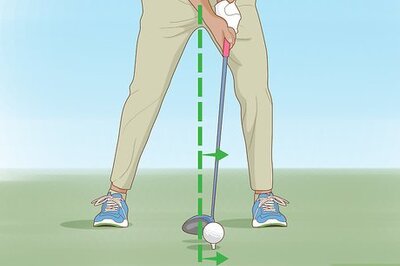
views
The SARS-CoV-2 virus needs no introduction. The pandemic is a race between scientific research and the virus as it continues its onslaught on humankind. From a treatment standpoint, apart from vaccines and a few practice-changing randomised clinical trials, there is little that science has been able to add to the traditional non-pharmaceutical interventions known since the past 100 years.
For instance, we don’t have an effective antiviral agent, we have not learned to completely avert its effects on various organ systems including the lungs and blood vessels, and we don’t have a method of stopping the virus from spreading within the body once it gets past our innate immune system. Theories are many, but we still do not know exactly why only some adults—regardless of their age—develop a stormy course, while others go through the infection without even knowing about it.
One of the problems with science in healthcare is that it follows certain set patterns or thought processes, with substantial influence from precedents. While this paradigm has certain advantages, such an approach also limits innovation. What needs to be done for the future is to look for newer ways of controlling the effects of the virus within the body.
At the same time, diligence must be exercised to detect, discourage, and discard commercially motivated scams that promise magical effects—often with little or no scientific evidence. As a rule, scamsters are able to convince people of their product better than scientists can. Scamsters come in all guises. In fact, some inventors are so convinced by the product they are promoting that they fail to understand that they are scamsters.
How the Virus Works: Cell Entry Mechanism of the Coronavirus
A virus is basically a dust-like particle that contains a piece of genetic code wrapped in a protein coat and sometimes, an additional fatty overcoat. It cannot move on its own or multiply without a host. That the SARS-CoV-2 virus has found an ideal host in man is an irrefutable fact—the pandemic is living proof.
If we are able to limit its ability to infect man using universal vaccination and non-pharmaceutical interventions, theoretically we can control the pandemic. This, however, is a substantial task, when we consider factors such as economic disparity, population density, and vaccine hesitancy across the world.
While looking at relatively unexplored therapeutic options, an area to focus on would be the course the virus takes after infecting the body—specifically in limiting its spread. COVID-19 is a biphasic illness; for most people, it settles down after the initial viremic phase. A minority go on to develop the immune-mediated second phase, where organ damage occurs to varying degrees. Clearly, a virus that cannot spread within the body cannot do any damage in the body. Unfortunately, at this point we do not have any method of limiting virus spread within the body.
Most of us have heard about the mechanism of entry of the SARS-CoV-2 virus into our cells. This involves ACE-2 receptors on which the virus attaches using its spike protein, following which the virus enters the cells, takes over the machinery and produces numerous replicas—using our own resources. These viruses must then find other cells to infect to keep the process going.
The question is whether the virus is able to spread to neighbouring cells through other means. In other words, does it always have to enter a cell by attaching itself to the ACE-2 receptor on the free surface of the cell?
The Importance of Understanding How the Coronavirus Replicates
As one can imagine, the body’s tissues are so vast, containing millions of cells that are stacked together. Free surfaces for cells are, in fact, a rare sight for the virus to find and infect. It is known that some viruses such as HIV-1 and measles also spread between cells using a “sideways mechanism”, utilising contact points between cells. In other words, they don’t always need a receptor on a cell surface to land on first, and then enter.
To put this in perspective simply, let us imagine a high-rise multi-apartment complex. A bug flies in through one of the open windows. Once it enters an apartment, imagine that it reproduces rapidly, and the newly formed bugs burrow through the walls to enter the surrounding apartment units. As the process repeats itself, this bug is able to infest the whole complex quickly—in enormous numbers. In contrast, a second type of bug that can only enter a room when a window is open and is incapable of burrowing through the walls, hence, is not able to achieve what the first bug could.
The presence of the sideways transmission possibility in the case of the SARS-CoV-2 virus was raised from well over a year ago. Researchers Anamika Basu and colleagues from Gurdas college and Jadavpur University Kolkata, India had published a pre-print on 26 May 2020, explaining how the virus can spread through mechanisms other than what was traditionally described for the SARS-CoV-2 virus. A few days ago, on June 1 2021, Cong Zeng and others from Ohio State University and Washington University confirmed that SARS-CoV-2 virus spreads efficiently by cell-to-cell entry—that is by sideways entry.
The virus uses intercellular adhesions—essentially sticky attachments between adjacent cells—sometimes riding in tiny vesicles called endosomes and utilising the cell’s own cytoskeleton in ways that suits its transmission. The importance of this process is that in the tight spaces between cells, there is no scope for the virus to be neutralised by our antibodies, which are typically seen near the free surface of the cell. Neutralising antibodies are a small subset of our total antibody production, which are able to attach to certain key points on the virus and stop it from attaching to the ACE-2 receptor and infecting the cell.
However, neutralising antibodies do not enter the tight intercellular spaces in significant amounts. The virus will thus be able to burrow its way right through multiple layers of cells—without being bothered by neutralising antibodies. This has been confirmed by Natalia Kruglova and colleagues from Gamaleya National Research Center, Moscow, in a preprint on May 5, 2021. They proved that the cell-to-cell entry process is almost entirely unaffected by the presence of neutralising antibodies.
While there are other immune mechanisms within the body to counter this, this cell-to-cell entry of the virus is indeed an area of concern. It also presents a possible opportunity in treatment.
In summary, the SARS-CoV-2 virus may enter the cell using ACE-2 receptor located on the cell’s exposed surface; yet its spread to other cells occurs not only through the receptor, but also involves a direct cell-to-cell infection process. Whether this cell-to-cell transmission can be effectively blocked pharmacologically, and whether such agents, once developed, will be safe and feasible for use in the pandemic are important questions for the future.
This article was first published on ORF.
Read all the Latest News, Breaking News and Coronavirus News here.




















Comments
0 comment